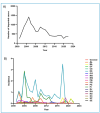Sociodemographic aspects, time series and high-risk clusters of malaria in the extra-Amazon region of Brazil: a 22-year study
- PMID: 39536215
- PMCID: PMC11656533
- DOI: 10.1590/0037-8682-0564-2023
Sociodemographic aspects, time series and high-risk clusters of malaria in the extra-Amazon region of Brazil: a 22-year study
Abstract
Background: Malaria is an acute febrile parasitic disease that significantly impacts global public health. In Brazil, the most studied endemic area for the disease is the Amazon region. This study aims to analyze temporal, spatial, and spatiotemporal patterns of malaria in the extra-Amazon region of Brazil over a 22-year period.
Methods: We conducted a time-series study from 2001 to 2022, encompassing both autochthonous and imported cases. Time trend analysis was employed to assess fluctuations in incidence rates over the years. Spatial clusters of infection risk were identified using the Local Moran Index and Kulldorff's scan.
Results: A total of 18,633 malaria cases were identified in the extra-Amazon region, including 1,980 autochthonous, 13,836 imported, and 2,817 of unknown origin. During the first period (2001-2011), 1,348 autochthonous and 9,124 imported cases were reported. In the second period (2012-2022), there were 632 autochthonous and 4,712 imported cases. The state of Espírito Santo exhibited a decreasing trend but maintained the highest incidence rates throughout the study. The number of municipalities at high risk for autochthonous cases declined, with Espírito Santo, Minas Gerais, and Piauí having the most municipalities with high rates. For imported cases, the federative units with the highest numbers in both periods were Ceará, Distrito Federal, Goiás, Minas Gerais, Piauí, and Paraná.
Conclusions: The data reveal the areas most affected by malaria and thus of highest priority for implementing control strategies.
Conflict of interest statement
Figures


Similar articles
-
Malaria time series in the extra-Amazon region of Brazil: epidemiological scenario and a two-year prediction model.Malar J. 2022 May 31;21(1):157. doi: 10.1186/s12936-022-04162-1. Malar J. 2022. PMID: 35641976 Free PMC article.
-
Spatial and temporal epidemiology of malaria in extra-Amazonian regions of Brazil.Malar J. 2015 Oct 15;14:408. doi: 10.1186/s12936-015-0934-6. Malar J. 2015. PMID: 26466889 Free PMC article.
-
Spatio-temporal relative risks and priority areas for visceral leishmaniasis control in Brazil, between 2001 and 2020.Acta Trop. 2023 Jun;242:106912. doi: 10.1016/j.actatropica.2023.106912. Epub 2023 Mar 28. Acta Trop. 2023. PMID: 36990374
-
Identification of priority areas for surveillance of cutaneous leishmaniasis using spatial analysis approaches in Southeastern Brazil.BMC Infect Dis. 2019 Apr 11;19(1):318. doi: 10.1186/s12879-019-3940-4. BMC Infect Dis. 2019. PMID: 30975100 Free PMC article.
-
Spatial and spatio-temporal analysis of malaria in the state of Acre, western Amazon, Brazil.Geospat Health. 2016 Nov 16;11(3):443. doi: 10.4081/gh.2016.443. Geospat Health. 2016. PMID: 27903051
Cited by
-
Factors associated with hospitalizations due to severe malaria in the non-endemic Brazilian region: a case-control study in the extra-Amazon Region from 2011 to 2019.Malar J. 2025 Jul 12;24(1):227. doi: 10.1186/s12936-025-05357-y. Malar J. 2025. PMID: 40652249 Free PMC article.
References
-
- Talapko J, Škrlec I, Alebić T, Jukić M, Včev A. Malaria: The Past and the Present. Microorganisms. 2019;7(6):179–179. https://www.mdpi.com/2076-2607/7/6/179/htm - PMC - PubMed
-
- World Health Organization (WHO) Malaria. WHO; Dec 23, 2023. [2022 Aug 14]. Available from: https://www.who.int/news-room/fact-sheets/detail/malaria .
-
- Ministry of Health (MH) Eliminate Malaria Brazil: National Plan to Eliminate Malaria. 1st edition. Brasília: MH; 2022. 60 p
MeSH terms
LinkOut - more resources
Full Text Sources
Medical

